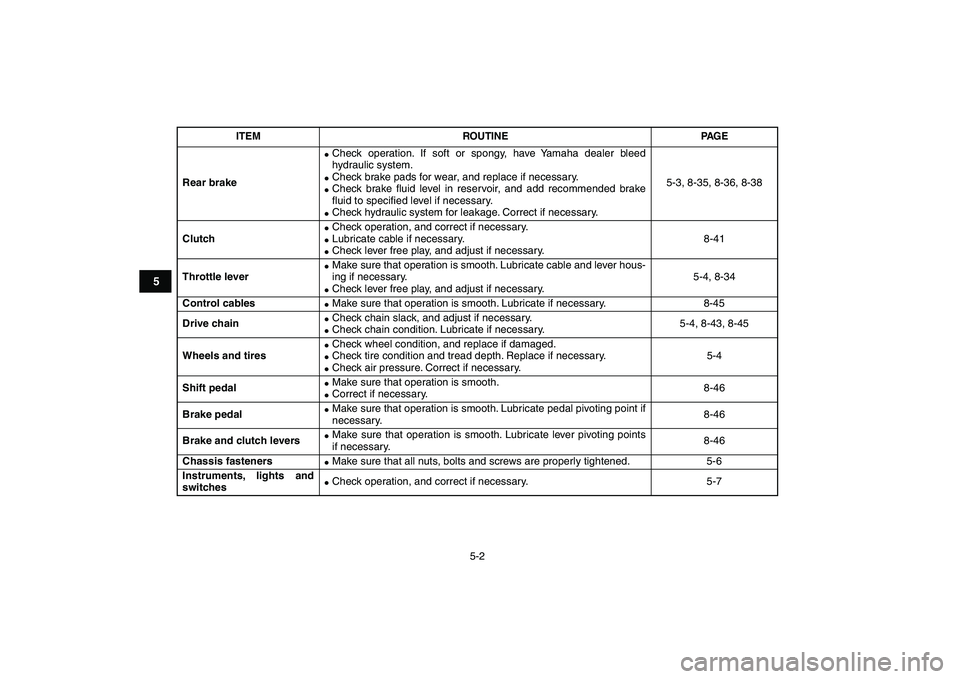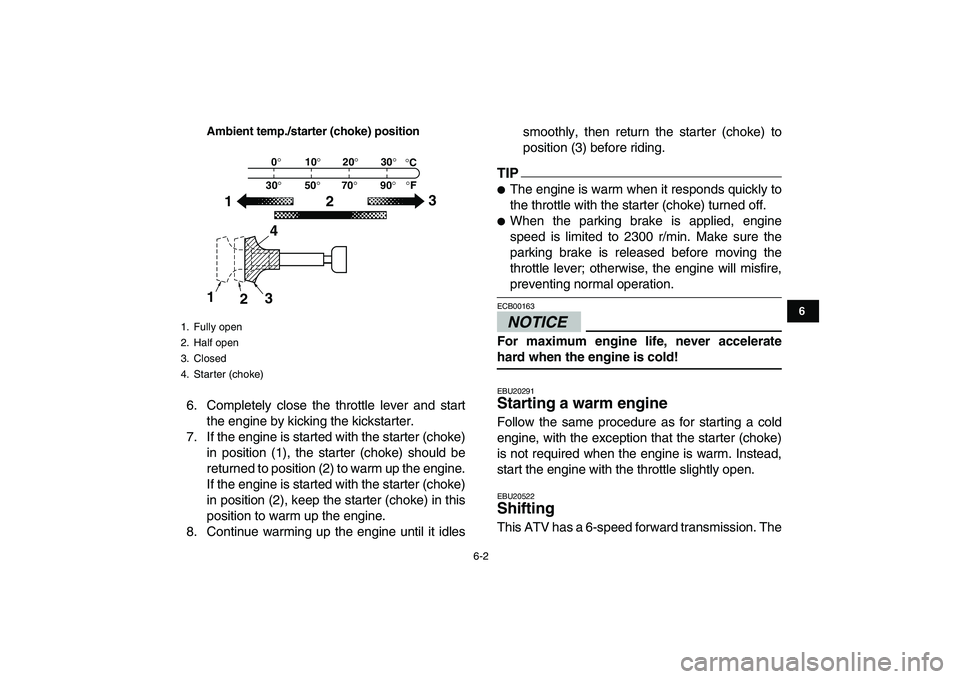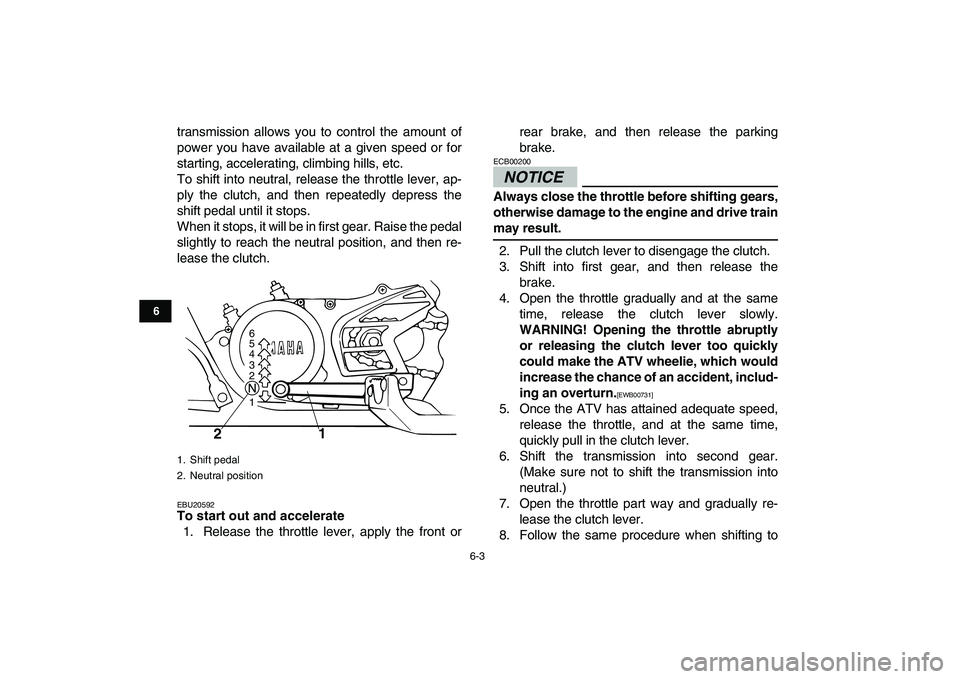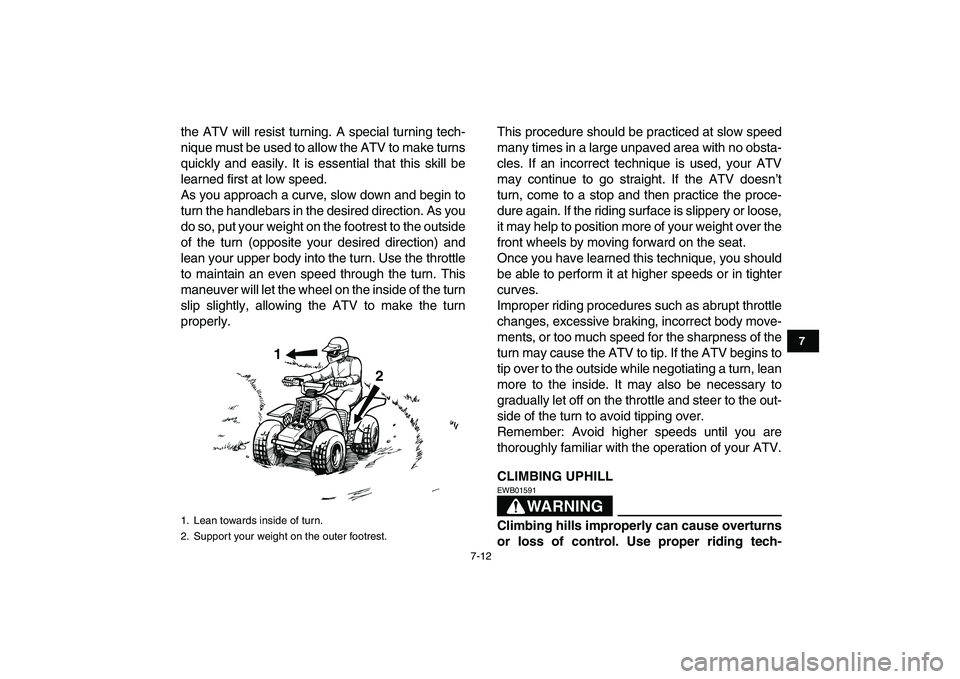Page 33 of 148
4-8
1
2
34
5
6
7
8
9
10
11
EBU18774
Fuel
Make sure there is sufficient gasoline in the tank.
WARNING
EWB02521
Gasoline and gasoline vapors are extremely
flammable. To avoid fires and explosions and
to reduce the risk of injury when refueling, fol-
low these instructions.
1. Before refueling, turn off the engine and be
sure that no one is sitting on the vehicle. Nev-
er refuel while smoking, or while in the vicinity
of sparks, open flames, or other sources of ig-nition such as the pilot lights of water heaters
and clothes dryers.
2. Do not overfill the fuel tank. When refueling,
be sure to insert the pump nozzle into the fuel
tank filler hole. Stop filling when the fuel reach-
es the bottom of the filler tube. Because fuel
expands when it heats up, heat from the en-
gine or the sun can cause fuel to spill out of
the fuel tank.
1. Fuel tank cap
1
1. Maximum fuel level
2. Filler tube
Page 44 of 148

5-2
1
2
3
45
6
7
8
9
10
11
Rear brake
�
Check operation. If soft or spongy, have Yamaha dealer bleed
hydraulic system.
�
Check brake pads for wear, and replace if necessary.
�
Check brake fluid level in reservoir, and add recommended brake
fluid to specified level if necessary.
�
Check hydraulic system for leakage. Correct if necessary.5-3, 8-35, 8-36, 8-38
Clutch
�
Check operation, and correct if necessary.
�
Lubricate cable if necessary.
�
Check lever free play, and adjust if necessary.8-41
Throttle lever
�
Make sure that operation is smooth. Lubricate cable and lever hous-
ing if necessary.
�
Check lever free play, and adjust if necessary.5-4, 8-34
Control cables
�
Make sure that operation is smooth. Lubricate if necessary. 8-45
Drive chain
�
Check chain slack, and adjust if necessary.
�
Check chain condition. Lubricate if necessary.5-4, 8-43, 8-45
Wheels and tires
�
Check wheel condition, and replace if damaged.
�
Check tire condition and tread depth. Replace if necessary.
�
Check air pressure. Correct if necessary.5-4
Shift pedal
�
Make sure that operation is smooth.
�
Correct if necessary.8-46
Brake pedal
�
Make sure that operation is smooth. Lubricate pedal pivoting point if
necessary.8-46
Brake and clutch levers
�
Make sure that operation is smooth. Lubricate lever pivoting points
if necessary.8-46
Chassis fasteners
�
Make sure that all nuts, bolts and screws are properly tightened. 5-6
Instruments, lights and
switches
�
Check operation, and correct if necessary. 5-7
ITEM ROUTINE PAGE
Page 49 of 148
5-7
1
2
3
45
6
7
8
9
10
11
EBU19850
Instruments, lights and switches
Check that all instruments, lights and switches are
working properly. Correct if necessary.
Page 51 of 148

6-2
1
2
3
4
56
7
8
9
10
11
Ambient temp./starter (choke) position
6. Completely close the throttle lever and start
the engine by kicking the kickstarter.
7. If the engine is started with the starter (choke)
in position (1), the starter (choke) should be
returned to position (2) to warm up the engine.
If the engine is started with the starter (choke)
in position (2), keep the starter (choke) in this
position to warm up the engine.
8. Continue warming up the engine until it idlessmoothly, then return the starter (choke) to
position (3) before riding.TIP
�
The engine is warm when it responds quickly to
the throttle with the starter (choke) turned off.
�
When the parking brake is applied, engine
speed is limited to 2300 r/min. Make sure the
parking brake is released before moving the
throttle lever; otherwise, the engine will misfire,
preventing normal operation.NOTICE
ECB00163
For maximum engine life, never accelerate
hard when the engine is cold!
EBU20291
Starting a warm engine
Follow the same procedure as for starting a cold
engine, with the exception that the starter (choke)
is not required when the engine is warm. Instead,
start the engine with the throttle slightly open.
EBU20522
Shifting
This ATV has a 6-speed forward transmission. The
1. Fully open
2. Half open
3. Closed
4. Starter (choke)
0°
30°10°20°30°
50°70°90°°F °C
123
1
234
Page 52 of 148

6-3
1
2
3
4
56
7
8
9
10
11
transmission allows you to control the amount of
power you have available at a given speed or for
starting, accelerating, climbing hills, etc.
To shift into neutral, release the throttle lever, ap-
ply the clutch, and then repeatedly depress the
shift pedal until it stops.
When it stops, it will be in first gear. Raise the pedal
slightly to reach the neutral position, and then re-
lease the clutch.
EBU20592
To start out and accelerate
1. Release the throttle lever, apply the front orrear brake, and then release the parking
brake.NOTICE
ECB00200
Always close the throttle before shifting gears,
otherwise damage to the engine and drive train
may result.
2. Pull the clutch lever to disengage the clutch.
3. Shift into first gear, and then release the
brake.
4. Open the throttle gradually and at the same
time, release the clutch lever slowly.
WARNING! Opening the throttle abruptly
or releasing the clutch lever too quickly
could make the ATV wheelie, which would
increase the chance of an accident, includ-
ing an overturn.
[EWB00731]
5. Once the ATV has attained adequate speed,
release the throttle, and at the same time,
quickly pull in the clutch lever.
6. Shift the transmission into second gear.
(Make sure not to shift the transmission into
neutral.)
7. Open the throttle part way and gradually re-
lease the clutch lever.
8. Follow the same procedure when shifting to
1. Shift pedal
2. Neutral position
6
5
4
1 2 3
1
2
Page 69 of 148

7-12
1
2
3
4
5
67
8
9
10
11
the ATV will resist turning. A special turning tech-
nique must be used to allow the ATV to make turns
quickly and easily. It is essential that this skill be
learned first at low speed.
As you approach a curve, slow down and begin to
turn the handlebars in the desired direction. As you
do so, put your weight on the footrest to the outside
of the turn (opposite your desired direction) and
lean your upper body into the turn. Use the throttle
to maintain an even speed through the turn. This
maneuver will let the wheel on the inside of the turn
slip slightly, allowing the ATV to make the turn
properly.This procedure should be practiced at slow speed
many times in a large unpaved area with no obsta-
cles. If an incorrect technique is used, your ATV
may continue to go straight. If the ATV doesn’t
turn, come to a stop and then practice the proce-
dure again. If the riding surface is slippery or loose,
it may help to position more of your weight over the
front wheels by moving forward on the seat.
Once you have learned this technique, you should
be able to perform it at higher speeds or in tighter
curves.
Improper riding procedures such as abrupt throttle
changes, excessive braking, incorrect body move-
ments, or too much speed for the sharpness of the
turn may cause the ATV to tip. If the ATV begins to
tip over to the outside while negotiating a turn, lean
more to the inside. It may also be necessary to
gradually let off on the throttle and steer to the out-
side of the turn to avoid tipping over.
Remember: Avoid higher speeds until you are
thoroughly familiar with the operation of your ATV.
CLIMBING UPHILL
WARNING
EWB01591
Climbing hills improperly can cause overturns
or loss of control. Use proper riding tech-
1. Lean towards inside of turn.
2. Support your weight on the outer footrest.
1
2
Page 73 of 148

7-16
1
2
3
4
5
67
8
9
10
11
stacles which may appear.
CROSSING A SLOPE
WARNING
EWB01632
Improperly crossing hills or turning on hills
could cause loss of control or cause the ATV to
overturn.
�
Always follow proper procedures as de-
scribed in the Owner’s Manual.
�
Avoid hills with excessively slippery or loose
surfaces.
�
Avoid crossing the side of a steep hill.
�
Shift your weight to the uphill side of the
ATV.
�
Never attempt to turn the ATV around on anyhill until you have mastered the turning tech-
nique as described in the Owner’s Manual on
level ground. Be very careful when turning
on any hill.
Traversing a sloping surface on your ATV requires
you to properly position your weight to maintain
proper balance. Be sure that you have learned the
basic riding skills on flat ground before attempting
to cross a sloping surface. Avoid slopes with slip-
pery surfaces or rough terrain that may upset your
balance.
As you travel across a slope, lean your body in the
uphill direction. It may be necessary to correct the
steering when riding on loose surfaces by pointing
the front wheels slightly uphill. When riding on
slopes, be sure not to make sharp turns either up
or down hill.
If your ATV does begin to tip over, gradually steer
in the downhill direction if there are no obstacles in
your path. As you regain proper balance, gradually
steer again in the direction you wish to travel.
OK
Page 85 of 148

8-7
1
2
3
4
5
6
78
9
10
11
15 *Rear suspension
relay arm and con-
necting arm pivot-
ing points
�
Check operation and correct if necessary.
�
Lubricate with lithium-soap-based grease.
√√√√
16 * Steering system
�
Check operation and repair or replace if damaged.
�
Check toe-in and adjust if necessary.
√√√√√
17 Transmission oil
�
Change.
�
Check ATV for oil leakage, and correct if neces-
sary.
√ √√√
18 Cooling system
�
Check coolant level and ATV for coolant leakage,
and correct if necessary.
√√√√√
�
Replace coolant. Every 2 years
19 *Moving parts and
cables
�
Lubricate.
√√√√
20 *Throttle lever hous-
ing and cable
�
Check operation and correct if necessary.
�
Check throttle lever free play and adjust if neces-
sary.
�
Lubricate throttle lever housing and cable.
√√√√√
21 *Front and rear brake
switches
�
Check operation and correct if necessary.
√√√√√
22 * Lights and switches
�
Check operation and correct if necessary.
�
Adjust headlight beams.
√√√√√
NO. ITEMCHECK OR MAINTENANCE
JOBINITIAL EVERY
Whichev-
er comes
firstmonth136612
km
(mi)320
(200)1300
(800)2500
(1600)2500
(1600)5000
(3200)
hours 20 80 160 160 320